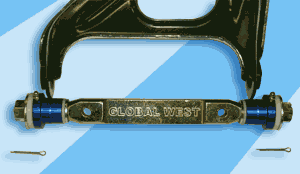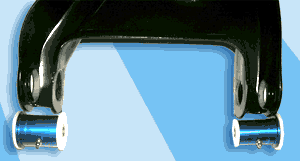| 

The pieces in this photo include
an upper bushing kit along with a billet cross shaft
for a ’68-’74 Nova or ’67-69 Camaro. Installation
is pretty much a breeze – The aluminum outer
bushings are pressed into place, followed by the Del-A-Lum
insert (which is installed by hand). Once slipped in,
the cross shaft is then drilled to accept a safety
cotter key to ensure that the nut doesn't back out. By
the way, Global West suggests the use of water resistant
synthetic grease as the lubricant for the bushings
(note the supplied grease fittings). |
Before looking closely at the actual bushings, let's examine
the word "deflection" for one minute: Deflection
is a pretty important term. And it's one that can plague
many bushing types. According to Global West: "Deflection
occurs when the bushing material distorts under loads generated
during cornering, accelerating and braking. The greater
these loads are, the more conventional bushings tend to deflect. This
bushing deflection allows the alignment settings to change
as the car is driven. Constant changes in alignment
setting cause the suspension to steer the car independently
of the input from the steering wheel."
Consider Global West's definition of deflection-- it's easy
to see how it can have a negative effect upon any racecar. In
the case of a drag car, if the front end is moving around
and deflecting under load, you know that energy is being
wasted. Couple the lack of deflection with the lack
of stiction and you can see that these bushings literally
beg to be used in the nose of any drag race door car.
When you break down the entire bushing (the whole system
can be disassembled and is completely serviceable), you can
see that the outer aluminum bushing housing is machined so
that it accepts a grease fitting. Internally, the aluminum
has a machined spiral pathway that allows grease to pass
through the entire housing. In turn, the Del-A-Lum
insert is radially drilled for the same purpose and also
incorporates a machined step in the center (again, an effort
to totally distribute grease). The Del-A-Lum insert
is an interference fit in the anodized aluminum housing (you
don't need a press or a hammer to install the insert -- it
just takes a bit or effort by hand to slip it into place).
How tough are these bushings? According to Global West,
they typically last 130,000 miles on a street driven car. That's
a bunch of trips down the quarter mile (and yes, they actually
have a warranty). Finally, there are no squeaks or
squawks from these bushings (certain after market bushings
dry out, then begin to seize, hence the noise).

On the lower control arm, the
installation is much the same, except you have to use
a reinforcement plate to support the control arm during
installation (supplied by Global West for the installation).
One thing to keep in mind is the orientation of the
grease fitting. You have to be able to access
it once the installation is complete! Just keep
an eye on the fitting location while pressing it into
place. |
Installation depends upon the application. Vintage
Corvette pieces are perhaps the most difficult to work with,
simply because there's a bit of simple fabrication involved. The
most difficult part of the installation is the modification
of the upper and lower control arm shaft so that it can accept
the Del-A-Lum bushings. Basically, the outer ends of
the shaft have special end stud links added, and then the
end studs are welded to the control arm shaft for added security. These "stud
links" replace the conventional cap screws that hold
the OEM bushings in place. Bolts cannot be used in
place of the stud links when the Del-A-Lum bushings are used. Why
not? Simple. They don't maintain the proper pre-load,
and according to Global West, they will back out. At
this point, a hole is drilled in the stud links so that a
cotter key can be used to ensure that the nut will never
back out. Now the shaft and control arm are ready to
accept the Del-A-Lum bushing. The aluminum bushing
housings are pressed into the control arms with a conventional
press. The lower control arm for the Corvette application
is similar, but a set of reinforcement plates is added to
the control arm over the bushing area. This isn't a
big job, but it does require a small amount of welding. Some
of the hardware is different (in terms of size) when compared
to the upper control arm, but the balance of the installation
process is the same. As you can see, none of the fabrication
required is over the head of any good racer. As for
other applications, most, such as the Camaro models shown
are a press-in replacement.
| SOURCE |
Global West Suspension Components Inc.
655 South Lincoln Avenue
San Bernardino Ca. 92408
PH: 877-470-2975; Fax 909-349-2095
www.Globalwestsuspension.com |
It should be no secret that I'm pretty high on these bushings. This
is for good reason: They work without stiction. The
deflection properties are zero. They have, in a drag
race application, an unlimited life span. The bushings
are serviceable in the field if necessary. The installation
doesn't require massive amounts of fabrication. The
costs are reasonable. And the pieces are well proven
and readily available. Try a set. I have a hunch
you'll be pleasantly surprised with the results.
|

